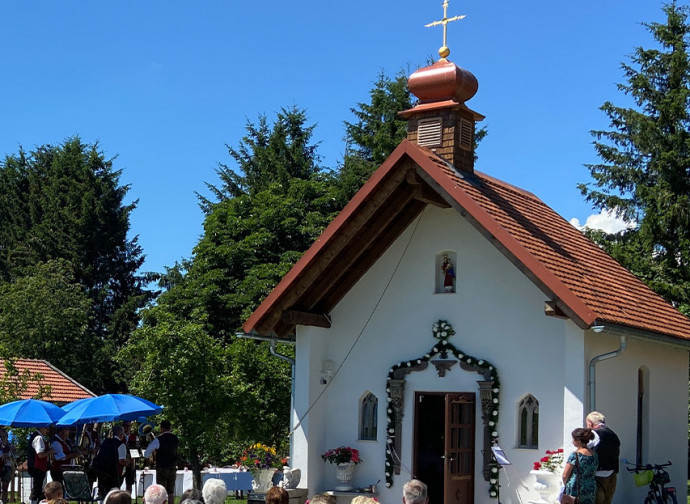Bavarian woman builds a church to fulfil a promise
A beautiful chapel gives visible and concrete form to a Bavarian woman's prayer for the healing of her son. It took Rosa Mühlberg three years to build it including parts built with her own hands. And it is more beautiful than many modern cathedrals. It’s proof that authentic sensus fidei also inspires true beauty.

A chapel built (almost) entirely with her own hands: this is the promise, finally realised, of Rosa Mühlberger, a 76-year-old German woman, mother of three, who has dedicated the last three years to the creation of this unique and splendid ex-voto, one piece at a time, drawing only on her own pension. Not something improvised and cobbled together. This is what happened in Breitenberg, a Bavarian municipality in the diocese of Passau, where the chapel was inaugurated on 26 June this year, and which recently the website Katholisch.de (from which the photos, which speak for themselves, are taken) is talking about again.
The typical style of the interior and exterior is in perfect harmony with many other small mountain churches, as if the small snow-white chapel with its wooden roof had been there for a few centuries or at least decades. After all, it is something that has always happened over the centuries, from the tiny chapels scattered across the countryside, to votive niches, and even imposing churches erected to implore divine help during a calamity or in thanksgiving for protection received.
There are actually as many as 16 ‘family chapels' in the parish of Maria Himmelfahrt in Sonnen, including the house (and church) of the Mühlberger family. Especially in the Austrian and German area, the custom of building small churches on one's own land is still widespread, open to the prayers of passers by. And they are family churches not only because they were built on their own land, but also because they have been handed down from generation to generation: “It's yours now”, Rosa told her son on the day of the inauguration, Sunday 26 June, confiding: “It's the most beautiful thing I'm going to leave him, and he has promised to take care of it”. Her grandchildren were also there: “I would like them to pray there, and for the Virgin to listen to their concerns. And I hope that the wishes of whoever spends time in the chapel will be granted. As happened to me three years ago". In fact, Rosa Mühlberger's chapel makes headlines, both for the beauty of this little gem (beauty that is increasingly rare in recent places of worship) and for the history behind its construction.
The chapel is also an ex-voto for the healing of her son, who was afflicted by an illness and an existential crisis. If he recovered, Rosa would build a chapel. But she herself makes it clear that she did not intend to 'negotiate' with the Lord: “I didn’t say: ‘Lord, you must help me’, but I asked him if he could. And He did help me”. Mrs Mühlberger fulfilled her promise with the same tenacity, patience, and faith with which she had overcome tribulations since childhood, suffering poverty after the war; but no difficulty ever prompted her to reproach God. On the contrary, she wanted to do something to thank Him. Her 83-year-old husband says he supported her “with his faith alone” (but adds that “he was not allowed to help”).
She herself committed her idea to paper, drawing it and then calling on a bricklayer and a carpenter to erect the walls and the roof. The daughter of a carpenter herself, equipped with only a couple of tools and memories of her father, she sawed the wood to build the benches and the 'old-fashioned' altar, which stands against the wall, with the celebrant facing ad Deum, because “there was no room for a detached altar” (truthfully, we add, it is not missed). She designed and painted every detail of it, finally bought the statues, had the stained-glass window with the Sacred Heart made (which was essential for her) and, when her money ran out, postponed the work to her next pension payment in order to continue. As for the outstanding bills she has to pay, she entrusts them to the large wooden crucifix from a church in Frankfurt that was demolished.
After three years of work, parish priest Wolgang Hann inaugurated the little church on 26 June, by celebrating Mass there and presenting it with the Certificate of Consecration from the bishop of Passau, Msgr Stefan Oster. The chapel holds about 15 people, even though 50 were present at the ceremony, partly gathered outside. The parish priest emphasised that the undertaking had started with a "personal plea", i.e. a request for healing, the fruit of which, however, benefits everyone: he urged that the chapel be filled with "living stones", and this is also the wish of Mrs Mühlberger, who is looking forward to pilgrims and visitors.
The pretty chapel in Breitenberg echoes that 'very Catholic and festive' Bavaria of Joseph Ratzinger's childhood. It is unclear whether the real news is the circumstances of its construction or the fact that it is more beautiful than many modern cathedrals. Certainly it is not the anonymous work of a starchitect, and it is not just made of wood and bricks, but of the tenacious faith of a mother, of popular devotion, of a sensus fidei not flaunted but lived in the concreteness of daily life and capable of generating an authentic instinct for beauty.




